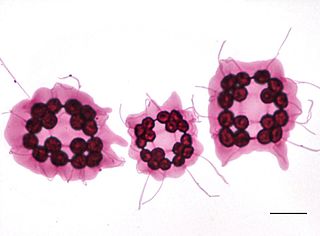
The Chlorophyceae are one of the classes of green algae, distinguished mainly on the basis of ultrastructural morphology. They are usually green due to the dominance of pigments chlorophyll a and chlorophyll b. The chloroplast may be discoid, plate-like, reticulate, cup-shaped, spiral- or ribbon-shaped in different species. Most of the members have one or more storage bodies called pyrenoids located in the chloroplast. Pyrenoids contain protein besides starch. Some green algae may store food in the form of oil droplets. They usually have a cell wall made up of an inner layer of cellulose and outer layer of pectose.

Volvox is a polyphyletic genus of chlorophyte green algae in the family Volvocaceae. Volvox species form spherical colonies of up to 50,000 cells, and for this reason they are sometimes called globe algae. They live in a variety of freshwater habitats, and were first reported by Antonie van Leeuwenhoek in 1700. Volvox diverged from unicellular ancestors approximately 200 million years ago.

Chlamydomonas is a genus of green algae consisting of about 150 species of unicellular flagellates, found in stagnant water and on damp soil, in freshwater, seawater, and even in snow as "snow algae". Chlamydomonas is used as a model organism for molecular biology, especially studies of flagellar motility and chloroplast dynamics, biogenesis, and genetics. One of the many striking features of Chlamydomonas is that it contains ion channels (channelrhodopsins) that are directly activated by light. Some regulatory systems of Chlamydomonas are more complex than their homologs in Gymnosperms, with evolutionarily related regulatory proteins being larger and containing additional domains.

Chlamydomonadales, also known as Volvocales, are an order of flagellated or pseudociliated green algae, specifically of the Chlorophyceae. Chlamydomonadales can form planar or spherical colonies. These vary from Gonium up to Volvox. Each cell has two flagella, and is similar in appearance to Chlamydomonas, with the flagella throughout the colony moving in coordination.
In botany, a zoid or zoïd is a reproductive cell that possesses one or more flagella, and is capable of independent movement. Zoid can refer to either an asexually reproductive spore or a sexually reproductive gamete. In sexually reproductive gametes, zoids can be either male or female depending on the species. For example, some brown alga (Phaeophyceae) reproduce by producing multi-flagellated male and female gametes that recombine to form the diploid sporangia. Zoids are primarily found in some protists, diatoms, green alga, brown alga, non-vascular plants, and a few vascular plants. The most common classification group that produces zoids is the heterokonts or stramenopiles. These include green alga, brown alga, oomycetes, and some protists. The term is generally not used to describe motile, flagellated sperm found in animals. Zoid is also commonly confused for zooid which is a single organism that is part of a colonial animal.

Botryococcus is a genus of green algae. The cells form an irregularly shaped aggregate. Thin filaments connect the cells. The cell body is ovoid, 6 to 10 μm long, and 3 to 6 μm wide. Fossils of the genus are known since Precambrian times, and form the single largest biological contributor to crude oil, and are a major component of oil shales.

Ankistrodesmus is a genus of green algae in the family Selenastraceae. It is one of the most common types of phytoplankton in freshwater habitats around the world.
Coelastropsis is a genus of green algae in the family Scenedesmaceae, containing the single species Coelastropsis costata. It is found in freshwater lakes and bogs, usually associated with mosses and filamentous algae. It has been recorded in Europe, Cuba and possibly New Zealand.

Desmodesmus is a genus of green algae in the family Scenedesmaceae. It is the only chlorophyll-containing organism known to have caused human infections in immunocompetent individuals. All known cases involved open injuries occurring in fresh water.
Neodesmus is a genus of green algae in the family Scenedesmaceae.

Pediastrum is a genus of green algae, in the family Hydrodictyaceae. It is a photoautotrophic, nonmotile coenobial green alga that inhabits freshwater environments.

Platydorina is a genus of microscopic green algae in the family Volvocaceae. It contains only one species, Platydorina caudata. It was described by Charles Atwood Kofoid in 1899.
Raphidocelis is a genus of green algae in the family Selenastraceae. They are found in freshwater habitats.
Selenastrum is a genus of green algae in the family Selenastraceae. It is common in freshwater habitats around the world. Most species prefer temperate or warm-temperate waters.

Sorastrum is a genus of green algae in the family Hydrodictyaceae. It is a component of the phytoplankton of freshwater ponds, lakes, and ditches. Sorastrum is common in tropical to temperate regions of the world, but due to its small size it is often overlooked.

Tetraspora is a genus of green algae in the family Tetrasporaceae of the order Chlamydomonadales, division Chlorophyta. Species of Tetraspora are unicellular green algae that exist in arrangements of four and consist of cells being packaged together in a gelatinous envelope that creates macroscopic colonies. These are primarily freshwater organisms, although there have been few cases where they have been found inhabiting marine environments and even contaminated water bodies. Tetraspora species can be found all around the globe, except in Antarctica. Despite the ubiquitous presence, the greatest growth of the genera's species is seen in the polar climatic zones.
Spinoclosterium is a genus of green algae, specifically of the Closteriaceae. It is rare, but widely distributed in freshwater regions throughout the world.

Nephrocytium is a genus of green algae in the class Chlorophyceae. Formerly placed in the family Oocystaceae, it is currently placed in its own family, Nephrocytiaceae.
Gilbertsmithia is a genus of green algae in the family Scenedesmaceae, containing the single species Gilbertsmithia grandis. It was named after the American botanist Gilbert Morgan Smith. This remarkable alga has only been recorded once from a muddy rainwater pool in Madras, India.
Korshikoviella is a genus of green algae in the family Characiaceae.












